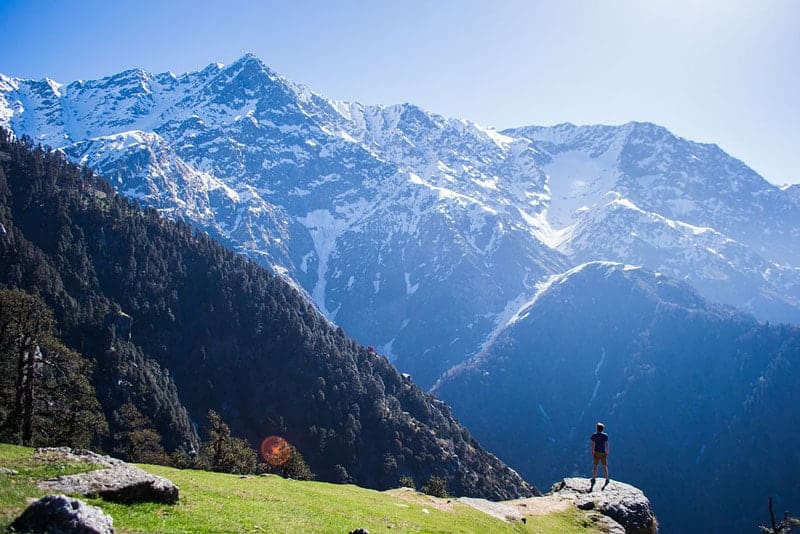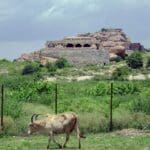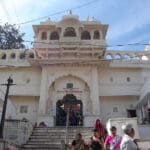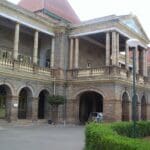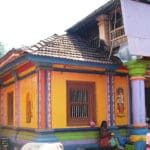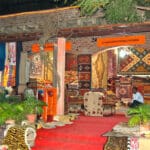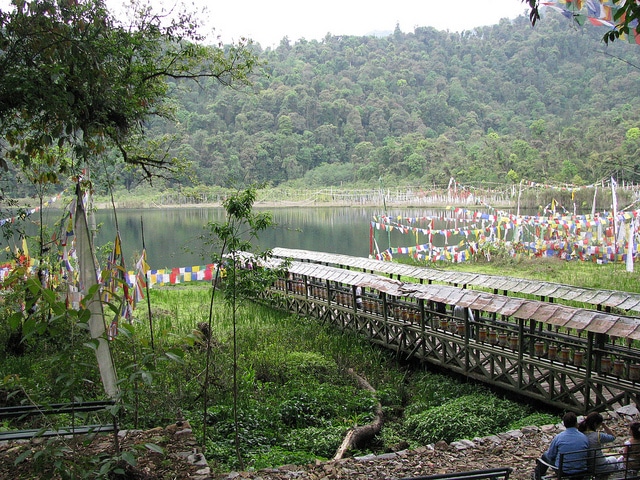Nestled in the serene embrace of the Dhauladhar mountains in Himachal Pradesh, Dharamkot, Mcleodganj, is a tranquil village that beckons travelers seeking peace, spirituality, and natural beauty. Situated just above the bustling town of Mcleodganj and a short distance from Dharamshala, this bohemian retreat offers a unique blend of Himalayan charm, Tibetan culture, and a laid-back vibe that captivates adventurers, spiritual seekers, and nature lovers alike. We invite you to explore this detailed guide to Dharamkot, Mcleodganj, where we uncover its rich history, vibrant culture, must-visit attractions, and practical travel tips to ensure an unforgettable journey.
Why Visit Dharamkot, Mcleodganj?
Dharamkot is a hidden gem in the Kangra Valley, offering a serene escape from the hustle and bustle of urban life. Unlike its more commercialized neighbor, Mcleodganj, known as the seat of His Holiness the Dalai Lama, Dharamkot exudes a hippie ambiance with its quaint cafes, yoga retreats, and breathtaking vistas. Perched at an altitude of approximately 6,900 feet, this village provides panoramic views of the Kangra Valley and the snow-capped Dhauladhar peaks. Whether you’re drawn to trekking, meditation, or simply soaking in the tranquility, Dharamkot, Mcleodganj, promises an experience that rejuvenates the soul.
The village’s unique charm lies in its ability to cater to diverse travelers. From backpackers seeking affordable guesthouses to spiritual seekers enrolling in yoga and meditation courses, Dharamkot is a melting pot of cultures and experiences. Its proximity to Mcleodganj (just 2 km away) makes it an ideal base for exploring the region while enjoying a quieter, more relaxed atmosphere. In this guide, we delve into every aspect of Dharamkot, Mcleodganj, from its history and culture to practical travel tips and hidden treasures.
A Brief History of Dharamkot and Mcleodganj
To truly appreciate Dharamkot, Mcleodganj, we must first understand its historical and cultural significance. Mcleodganj, often referred to as “Little Lhasa”, is the heart of the Tibetan exile community in India. Following the Dalai Lama’s escape from Tibet in 1959, Mcleodganj became a hub for Tibetan refugees, who brought with them their rich cultural heritage, Buddhist practices, and vibrant traditions. The presence of the Dalai Lama’s residence and the Namgyal Monastery has made Mcleodganj a global center for Tibetan Buddhism.
Dharamkot, located just above Mcleodganj, has evolved into a peaceful extension of this cultural hub. Originally a small Himalayan village, Dharamkot gained prominence as a retreat for those seeking solitude and spiritual growth. Over the years, it has attracted yogis, artists, and travelers from around the world, creating a unique fusion of Indian, Tibetan, and Western influences. The village’s history is intertwined with the broader narrative of Dharamshala, which was established as a British hill station in the 19th century and later became a significant center for Tibetan culture in exile.
Today, Dharamkot is known for its eclectic community, where locals, Tibetan monks, and international visitors coexist harmoniously. The village’s laid-back vibe, coupled with its proximity to Mcleodganj’s spiritual landmarks, makes it a perfect destination for those seeking both adventure and introspection.
Getting to Dharamkot, Mcleodganj
Reaching Dharamkot, Mcleodganj, is a straightforward journey, thanks to its excellent connectivity to major Indian cities. We outline the best ways to travel to this Himalayan paradise below.
By Air
The nearest airport to Dharamkot is Gaggal Airport (also known as Kangra Airport), located approximately 20 km from Dharamshala. The airport serves domestic flights from cities like Delhi, Chandigarh, and Mumbai. Airlines such as SpiceJet, IndiGo, and Air India operate regular flights to Gaggal. From the airport, you can hire a taxi or take a shared cab to Dharamkot, which takes about 45 minutes to 1 hour, depending on traffic.
By Train
The closest major railway station is Pathankot Junction, approximately 90 km from Dharamkot. Pathankot is well-connected to major cities like Delhi, Mumbai, Jaipur, and Amritsar via overnight trains such as the Jammu Mail and Dhauladhar Express. From Pathankot, you can hire a taxi or board a state-run bus to Dharamshala or Mcleodganj, followed by a short 2 km ride to Dharamkot. For a unique experience, consider taking the narrow-gauge toy train from Pathankot to Kangra, which offers scenic views of the Kangra Valley before continuing by road to Dharamkot.
By Road
Dharamkot is easily accessible by road from Delhi (approximately 520 km), Chandigarh (approximately 250 km), and other major cities in North India. Several private bus operators, such as HRTC (Himachal Road Transport Corporation), Volvo, and luxury coaches, run overnight services from Delhi’s ISBT Kashmiri Gate, Majnu ka Tila, or Ramakrishna Ashram Marg. The journey takes about 10-12 hours, with drop-off points at Mcleodganj or Dharamshala bus stands. From Mcleodganj, Dharamkot is a quick 20-minute taxi ride or a scenic 30-minute walk through pine forests.
For those who prefer driving, the route from Delhi to Dharamkot via NH44 and NH503 offers stunning views of the Punjab plains and the Himalayan foothills. However, be prepared for winding mountain roads as you approach Dharamshala.
Local Transport
Once in Mcleodganj, reaching **Dharnums, and Himalayan adventures. Whether you’re a first-time visitor or a seasoned traveler, Dharamkot, Mcleodganj, promises a transformative experience that blends adventure, spirituality, and cultural immersion.
Food and Dining: Diverse & Healthy
Vegetarian, vegan, and gluten-free options are abundant. Dharamkot’s culinary scene emphasizes:
-
Locally sourced produce.
-
Global fusion—from Israeli bakeries to Tibetan vegan thalis.
-
Cooking classes and community feasts highlight regional Himachali and Tibetan dishes.
Tibetan Culture Exploration in Mcleodganj
Mcleodganj, just downhill, is the epicenter of Tibetan Buddhist culture in India. Visitors can:
-
Visit monasteries: Namgyal Monastery, Tsuglagkhang Complex.
-
Shop at Tibetan markets: Prayer flags, thangka art, incense, jewelry.
-
Engage with local NGOs or volunteer: Buddhist education, environment, animal welfare.
Hidden Gems and Offbeat Experiences
-
Naddi Village: Walk for quieter Himalayan views and bird-watching.
-
Vipassana Meditation Centre: Explore intensive 10-day silent retreats.
-
Volunteer with Eco NGOs: Join tree-planting or community clean-up drives.
Travel Tips: When to Visit and What to Pack
-
Best Seasons: March–May and September–November for trekking and serenity.
-
Packing: Layered clothing, sturdy shoes, rain jacket, travel yoga mat, reusable water bottle.
Digital Nomads and Long Stays
With stable Wi-Fi in many guesthouses and hostels, Dharamkot has become a haven for remote workers. Monthly rentals, communal spaces, and a creative peer group support extended stays.
Health and Safety
-
Basic clinics and pharmacies in Mcleodganj.
-
Good safety record for solo and women travelers—standard precautions encouraged.
-
Respect local beliefs and eco-rules (no littering, quiet nights).
Shopping: Himalayan Handicrafts
Unique souvenirs include:
-
Tibetan singing bowls, prayer flags, thangka paintings.
-
Handwoven woolens, jewelry, natural wellness products, teas, and spices.
Day Trips & Extended Excursions
-
Bhagsu Waterfall & Temple: Short hike from Dharamkot.
-
Dal Lake: Peaceful walks amidst giant deodars.
-
Kareri Lake Trek: For the fit and adventurous.
Making the Most of Your Trip
-
Stay at least 4-5 days to balance adventure and reflection.
-
Mix solo time with group treks, workshops, and café conversations.
-
Opt for eco-friendly travel and support local businesses.
FAQs
-
What is the best time to visit Dharamkot, Mcleodganj?
The best times are March to May for mild weather and October to November for clear skies and stunning mountain views. Winter (December to February) offers snowfall but may restrict trekking. -
How far is Dharamkot from Mcleodganj?
Dharamkot is approximately 2 km from Mcleodganj, a 20-minute taxi ride or a 30-minute scenic walk. -
Is Dharamkot suitable for solo travelers?
Yes, Dharamkot is safe and welcoming for solo travelers, with affordable hostels, vibrant cafes, and a friendly community. -
What are the must-visit attractions in Dharamkot?
Key attractions include Galu Devi Temple, Tushita Meditation Centre, Bhagsu Waterfall, and the Triund Trek. -
Are there yoga retreats in Dharamkot?
Dharamkot is known as the Yoga Capital of India, offering numerous yoga and meditation retreats at centers like Himalayan Iyengar Yoga Centre and Tushita. -
What is the difficulty level of the Triund Trek?
The Triund Trek is moderately challenging, suitable for beginners with basic fitness. It takes 4-6 hours one way, covering 9 km. -
Can I visit Dharamkot during the monsoon season?
Yes, but expect heavy rainfall and slippery trails. Focus on indoor activities like meditation and cooking classes. -
What food options are available in Dharamkot?
Dharamkot offers diverse cuisines, including Tibetan, Indian, Israeli, and continental dishes at cafes like Alt Life and Shiva Cafe. -
How do I reach Dharamkot from Delhi?
Take a flight to Gaggal Airport, an overnight train to Pathankot, or a Volvo bus from Delhi. From Mcleodganj, Dharamkot is a short taxi ride or walk. -
Are there ATMs in Dharamkot?
ATMs are limited in Dharamkot, but available in Mcleodganj. Carry cash for smaller establishments, though digital payments are widely accepted.


